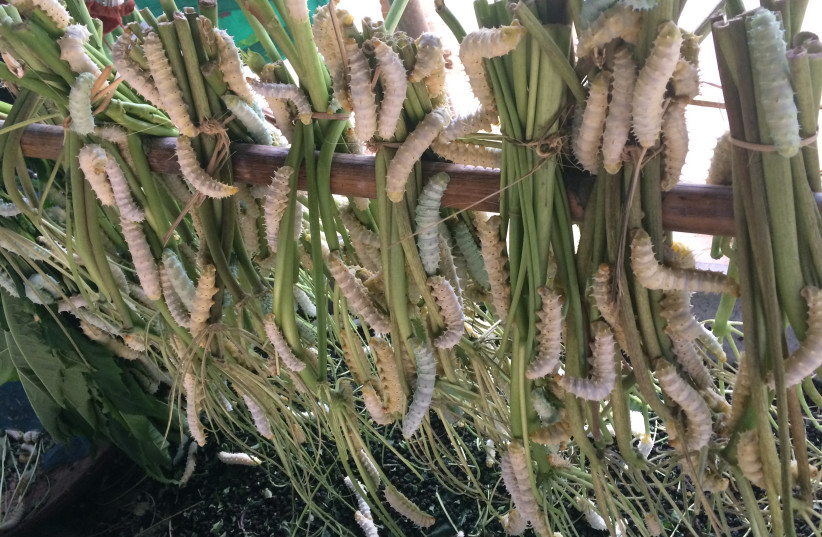Scientists have unlocked genetic mysteries behind finer silk, according to a study published a couple of weeks ago.
Due to the limited availability of wild silkworms in the past, many trait-associated sites were missing in the genome. But by building a high-resolution pan-genome dataset that represents almost the entire genomic content in the silkworm, BGI Genomics, along with Southwest University, the State Key Laboratory of Silkworm Genome Biology and other partners, became the first to digitize the silkworm gene pool. Their research facilitates functional genomic research, promotes precise breeding and enables more silk use cases.
The study was published in the peer-reviewed journal Nature Communications on September 24.
“This ushers in a new era for silkworm basic research and molecular breeding and provides guidelines for the large-scale pan-genome research of other species."
Xiaoling Tong
“Genomic data greatly accelerated the development of biological research in the last two decades,” writes lead study author Xiaoling Tong. “Recently, the focus of genome research has shifted from a single reference genome to a pan-genome approach that provides greater insights into the entire genomic content of a species.”
The team deeply re-sequenced 1,078 silkworms and assembled long-read genomes on 545 of the samples. The resulting pan-genome dataset is the largest long-read pan-genome in the world for plants and animals, including the most comprehensive information on the genomes of wild and domestic silkworms.
The research findings also provided insights into artificial selection, or domestication and breeding, and ecological adaptation.
From where do domestic silkworms originate?
Bombyx mori, the domestic silkworm, was domesticated from B. mandarina, the wild mulberry silkworm. Due to lacking biological evidence, the domestication origin remains in question.
This study revealed that endemic species from China's lower and middle Yellow River region are distributed at the base of the domestic silkworm branch on the evolutionary tree. From this, the researchers suggest that B. mori originated in this region. Providing support to this suggestion is the half cocoon excavated at Xiyin Village, Xia County, Shanxi Province in 1926, and the stone-carved silkworm pupa excavated at Shicun in the same county in 2019.
Since the 1990s, silkworm breeding has remained in gridlock.
Genetics of silkworms
THE TEAM identified 468 domestication-associated genes and 198 improvement-associated genes. Of these, 264 and 185 are newly found. Solving the unresolved issues in silkworm breeding, these genes will be vital for the molecular improvement of the silk-producing creature.
“Compared with prior studies, the current report represents an additional set of 264 genes associated with domestication and 185 genes associated with improvement,” notes Tong. “The analysis of the functions of these genes will reveal the genetic basis of artificial selection, provide improvement targets, and promote our understanding of the behavior differences between B. mori and B. mandarina, such as larval ability to withstand crowding and handling, relatively docile feeding (without a strong drive for finding food), and loss of flight ability.”
Furthermore, the study found that the Chinese and Japanese species share less than three percent of the improvement loci, shedding new insights for future breeding of the silkworm.
“This study reveals differences between the artificial selection loci of the Chinese and Japanese improvement lines, which will help unravel the underlying basis of hybrid vigor generated from these two populations and aid in the design of better combinations of beneficial loci for subsequent improvement of silkworm,” writes Tong.
The main economic criteria for the artificial selection of silkworms have been their production and quality for a very long time. Through analyzing rare variants in the genomes of fine silk, the researchers identified BmChit β-GlcNAcase, a gene that controls silk fineness and can be detected in fine varieties, and CRISPR-cas9 which mediated knockout of BmE2F1, resulting in coarser silk fineness produced by domestic silkworms. Overall, these findings suggest that this gene plays a big role in determining silk fineness.
“Furthermore, our application of a large-scale pan-genome to decipher two genes that control important economic traits in silkworms may also be used to reveal genetic mechanisms and traits associated with the survival of wild populations and evolution of new species under strong natural selection by human and non-human factors,” Tong writes.
Diapause, a common ecological adaptive trait in insects, helps insects survive despite environmental conditions that aren't ideal. This study, through analysis of genomic structural variation of the silkworm and functional validation by gene editing, discovers a gene that is vital in the determinant of post-embryonic stalling, becoming the first to identify a post-embryonic determinant gene in an insect.
“Our results show that the generated pan-genome, based on hundreds of long-read sequenced genomes, provides resources for high-throughput and accurate assessment of valuable alleles for silkworm functional genomics research and breeding,” Tong concludes. “This ushers in a new era for silkworm basic research and molecular breeding and provides guidelines for the large-scale pan-genome research of other species."

